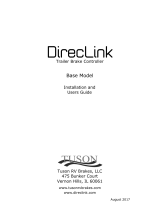
PAGE 12
NOTE: Stoplight switch connection on Ford vehicles including, Mercury Mountaineer.
Do not connect to the red wire with a green stripe. Connect to the light green wire only.
For vehicles other than 1989-1991 Ford E and F Series trucks and vans with
anti-lock brakes, use a test probe, determine which wire on the tow vehicle's
stoplight switch is only "hot" when the pedal is pressed. Splice the brake
control's red wire to this wire using a wire tap.
For 1989-1991 Ford E and F Series trucks and vans with anti-lock brakes:
Find the crescent shaped connector located on the steering column, the connector
has two rows of wires. The wire needed is the light green wire, second from the end
in the outside row of seven wires (see the box shown in wiring the diagram). Splice
the brake control brake control's red wire to light green wire using a wire tap.
Using 10 gauge stranded wire and ring terminals, connect the
"BATT" side of the circuit breaker to the positive battery terminal.
Attach the white 10 gauge wire previously positioned near the battery to the
negative battery terminal using a ring terminal. Reconnect the tow vehicle's
negative battery terminal to its battery post. See vehicle's owner's manual for
special battery re-connection instructions.
Test the installation without a trailer connected, by pushing the brake pedal. A single
decimal point should light up on the display. If the decimal point does not light, or
if , or is shown refer to display messages. After testing secure all
loose wires with cable ties so that they will not be damaged.




















